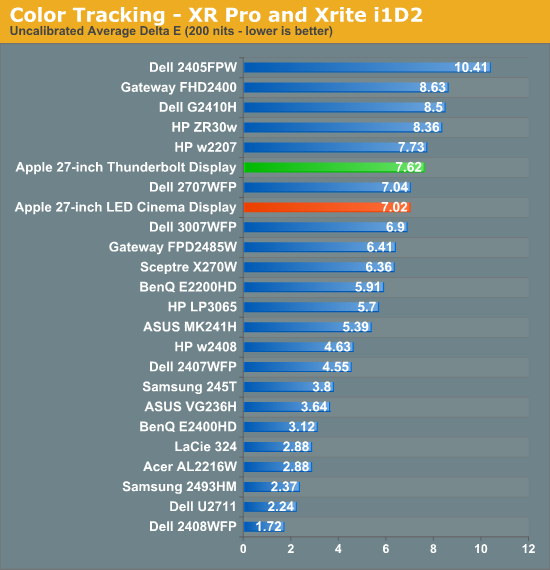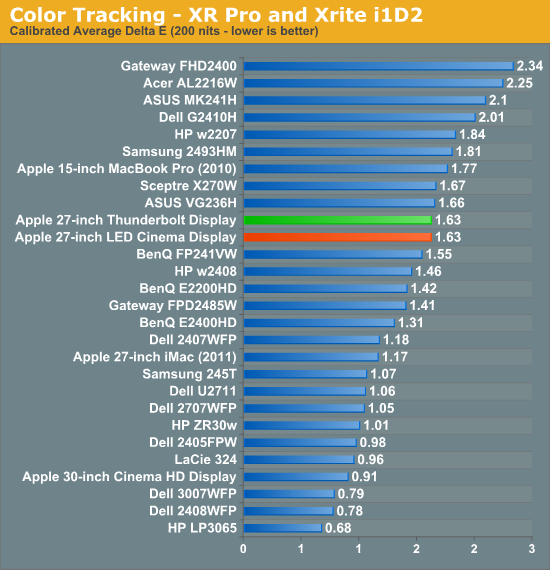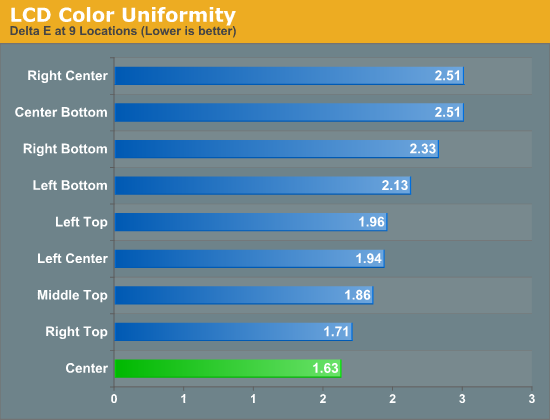The Apple Thunderbolt Display Review
by Anand Lal Shimpi on September 23, 2011 2:56 AM EST- Posted in
- Displays
- Mac
- Apple
- Thunderbolt
- Thunderbolt Display
Display Testing
With all of the extra connectivity there is to test with the Thunderbolt Display we can't forget the actual panel testing. Thankfully this part is pretty simple, the display characteristics are near identical to the 27-inch LED Cinema Display we reviewed last year.
Color Quality
We report two main quality metrics in our display reviews: color accuracy (Delta-E) and color gamut. Color gamut refers to the range of colors the display is able to represent with respect to some color space. In this case, our reference is the AdobeRGB 1998 color space, which is larger than the sRGB color space. So our percentages are reported with respect to this number, and larger is generally better.
Color accuracy (Delta E) refers to the display’s ability to display the correct color requested by the GPU and OS. The difference between the color represented by the display, and the color requested by the GPU is our Delta-E, and lower is better here. In practice, a Delta E under 1.0 is perfect - the chromatic sensitivity of the human eye is not great enough to distinguish a difference. Moving up, a Delta E of 2.0 or less is generally considered fit for use in a professional imaging environment - it isn’t perfect, but it’s hard to gauge the difference. Finally, Delta E of 4.0 and above is considered visible with the human eye. Of course, the big consideration here is frame of reference; unless you have another monitor or some print samples (color checker card) to compare your display with, you probably won’t notice. That is, until you print or view media on another monitor. Then the difference will no doubt be apparent.
As I mentioned in our earlier reviews, we’ve updated our display test bench. We’ve deprecated the Monaco Optix XR Pro colorimeter in favor of an Xrite i1D2 since there are no longer up-to-date drivers for modern platforms.
For these tests, we calibrate the display and try to obtain the best Delta-E we can get at 200 nits of brightness for normal use. We target 6500K and a gamma of 2.2, but sometimes the best performance lies at native temperature and another gamma, so we try to find what the absolute best performance could be. We also take an uncalibrated measurement to show performance out of the box using either the manufacturer supplied color profile, or a generic one with no LUT data. For all of these, dynamic contrast is disabled.

Uncalibrated performance remains fairly similar to last year's LED Cinema Display, however once calibrated the Thunderbolt Display is spot on with its predecessor:

As we mentioned earlier, a sub 2.0 delta E is good enough for professional use. Although not perfect the Thunderbolt Display falls within that range for sure.


We measured slightly lower color gamut on the Thunderbolt Display than the original LED Cinema Display, however the result was much closer to the 2011 27-inch iMac. I couldn't visibly tell any differences and Apple indicates that color gamut shouldn't have changed, so it's quite possible that the differences here are due to our colorimeter and not the panel.
Color Uniformity
Now for color consistency, we take our best calibration profile from the very center at 200 nits and test color accuracy at 9 different places around the LCD display in an evenly distributed grid. We’ve shown before that calibration is localized across the display, partly due to the brightness not being uniform, partly due to the discrete nature of the display itself.

The Thunderbolt Display was fairly uniform across its surface, something we noticed in reviewing the 27-inch LED Cinema Display last year. Uniformity is actually better on this panel than the one we reviewed last year, although in both cases I couldn't really tell any differences.
Peak brightness appears down slightly, but so are the black levels which result in a slightly better contrast ratio. Apple is also calibrating these things at the factory now so white points are now set at around 6300K vs. 7100K on the original 27-inch LED Cinema Display.










275 Comments
View All Comments
mczak - Friday, September 23, 2011 - link
I'm wondering what the performance would be like? Looks to me like you'd get a far bigger performance hit in this case.Constructor - Friday, September 23, 2011 - link
That would be very interesting indeed.In a discussion over at ars I've been speculating about some of the possible complications with that setup:
http://arstechnica.com/civis/viewtopic.php?t=11558...
(Same user name there.)
Anand, it would be very interesting if you could find out more about the inner workings and the performance consequences of such a combination, possibly confirming or disproving my speculation on the matter.
Over at Macworld they even seem to have made a Cinema display work when plugged in to a Pegasus RAID daisy-chained to a Thunderbolt display. The implications of that and the potential impact on Thunderbolt throughput would be most interesting as well... ;-)
AlexCheng - Friday, September 23, 2011 - link
Sorry guys, but maybe I didn't quite catch it; what exactly is it using as its power supply source? Because it said that the MagSafe port could charge your MacBooks, then where the hell is the cable for its power??Constructor - Friday, September 23, 2011 - link
The display has an ordinary power cable which you'll need to plug into a wall outlet. And the display then powers and charges the MacBok Air/Pro.ltcommanderdata - Friday, September 23, 2011 - link
If Apple goes through with removing the optical drive for the MacBook Pro, hopefully they'll add an optical drive to the Thunderbolt Display. That would make the Thunderbolt Display very complete as a dock.dBoze - Friday, September 23, 2011 - link
Anand,When you mention there is "no analog audio out", I think the inclusion of even analog audio would be a bit of a slap in the face. All Macs in recent history include digital audio through the 1/8" jack via 1/8" TOSLINK, Us Mac users are far too cool for analog ;).
Another solution for digital audio without an extra cable to your MacBook would be using AirPort Express. This will give you a digital or audio connection to your speakers over the network, and you can even plug it into your network via ethernet if your wireless signal isn't too strong. If I recall correctly, you can choose your AirPort Express as the "device for sound output" under the "Output" tab in "Sound" under sys preferences. Of course, you're limited to using AirPlay-compatible applications (iTunes) on the Windows side of things.
Constructor - Friday, September 23, 2011 - link
All recent Macs have both analog (electrical) and digital (optical) audio ports in the same socket. Analog is for convenience, digital is for avoidance of ground loops and of analog signal degradation.An additional audio port (USB/FireWire/Thunderbolt) is possible, if inconvenient.
stanwood - Friday, September 23, 2011 - link
Nice review!A lot of comments about how Apple could have built this display is a way that made it more easily upgradable. This is a PC mentality (which I share). Apple rejects it. Don't waste your time asking for it. If you must have some Mac love, use these 3 simple rules:
1) Buy all your Apple gear in a single release cycle.
1a) Go ahead and upgrade the OS. Those are actually pretty cheap.
2) Use it until you hate it or can't resist getting the new shiny stuff.
3) Give it all to your grandfather, aunt, or Goodwill and return to step 1.
By the time you get to step 3 Apple will have replaced all the important I/Os. There will be no point in trying to upgrade.
mcnabney - Friday, September 23, 2011 - link
Large, high quality displays are expensive, but last a long time. The iMac and displays like this compell people to discard those expensive displays far ahead of their time and likely buy another display of the same size and resolution.My 27" display is on its third computer and it provides better color accuracy than this expensive new one. That is probably my biggest beef with Apple, sending so many nice IPS displays into the trash/closet long before they wear out or become outdated.
slashbinslashbash - Friday, September 23, 2011 - link
Not any more. Starting with the 2010 27" iMac, there was a DisplayPort which was both an input and an output. Now with all the 2011 iMacs having Thunderbolt, they can all be used as displays for other computers with Thunderbolt display output.